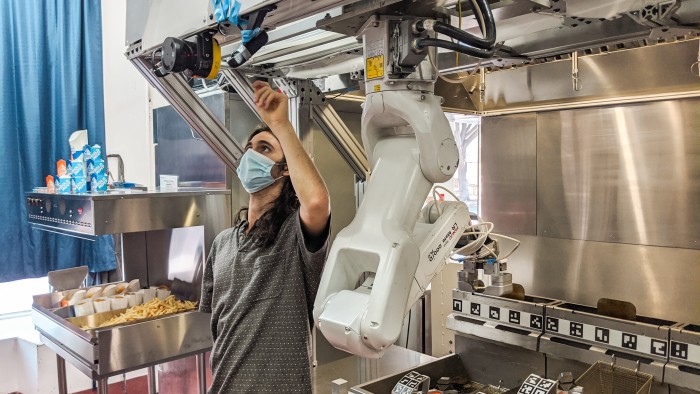The flipside of the AI jobs revolution

Simply sign up to the Artificial intelligence myFT Digest -- delivered directly to your inbox.
Humanity has long had an uneasy relationship with artificial intelligence. For decades, popular culture furnished us with visions of androids in revolt, overthrowing their fleshy masters. As automation crept into workplaces, that fear took second place to a more banal dystopian vision — a future in which machines would simply replace workers.
That concern has only been heightened by coronavirus. Research released in December (of which more later) warned that in the UK, sectors such as hospitality and retail — already reeling from Covid-19 shutdowns — are most at risk from the acceleration of workplace automation during the pandemic, although many other jobs are unsafe.
Business leaders face a choice in how they implement innovative technologies such as AI and industrial robots. The long-term view, which will enrich society, is to treat these tools as force multipliers and invest heavily in ensuring employees have the skills to best make use of them. The alternative is to sleepwalk into a hollowing-out of the labour market, with those already suffering during the coronavirus crisis often most at risk.
Talk about “the rise of the robots” conjures up images of physical hardware on factory lines. Indeed, White Castle, the US fast-food chain, has been experimenting with a rather unusual fry chef that does not need to socially distance or self-isolate: an automated arm called Flippy, created by Miso Robotics. In Japan, the number of robots exported rose at an annual rate of 13 per cent in the second quarter of 2020, according to the Japan Robot Association.
But even more endemic has been the rise of automated interfaces, as consumers have found themselves unable to visit shops or restaurants, instead buying goods via a browser or ordering takeaways via apps. Even high streets that survive the lockdown may find that their former customers prefer to avoid the hassle of a trip into town.
Others are less glum about automation, including Michael Priddis, chief executive of Faethm AI, a SaaS (software as a service) company that provides data on how technology will affect workforces and helps employers to reskill them. “Our analysis for most developed countries is that over the next five years, augmentation is the single biggest impact,” Priddis says. New technologies will help improve the productivity of many workers by carrying out the repetitive parts of their labour, rather than simply replacing them.
Priddis is also optimistic for many whose jobs are under threat of automation. For example, he predicts a declining requirement for accountants over the next decade as robots take up much of the work. At the same time, as our reliance on digital services grows, cyber-security professionals are likely to be in even shorter supply. “When you peel back job titles and look at their constituent parts, what you see is a large number of similarities between [the two professions],” he says. “It doesn’t make sense for people to be spending money on job loss and rehiring . . . Your future employees work for you. They’re just in different jobs.”
For future business leaders such as MBA students, internal investment and ensuring education is fit for purpose will be vital to support sustainable economic growth. Having a direct understanding of which jobs and skills are required, they can also play a valuable role informing government policy around education.
This will be especially important for those in low-paid and lower-skilled jobs at the sharp edge of automation, and whose time for retraining is especially limited. The December research, part of a two-year inquiry by a commission set up by Community, the UK trade union, and think-tank the Fabian Society, called for an overhaul of the British adult education system, the sort of proactive thinking that business leaders may support.
Business people should also consider what new roles can and should be created. As Priddis notes: “Computers are good at what we find hard, and bad at what we find easy.” The problem for employers is that the majority of jobs are better suited to machines: repetitive tasks, calculations, heavy lifting and so on.
With automation, there is the possibility of shifting more workers to tasks that rely on skills humans possess but robots do not, such as empathy, creativity, motivation and the ability to understand multiple contexts. The phrase “most of our children’s jobs do not exist yet” may have become a cliché and of questionable accuracy. But breakthroughs in new technologies offer the possibility to restructure the world of work — as long as solid, coherent reskilling programmes are in place.
It is now a year since the world first heard of a strange ailment appearing in central China. In a decade or so featuring the Arab uprising, Brexit, Donald Trump’s victory and loss, and more, few could have predicted that the defining feature would be a pandemic.
Automation is not an easy solution to the problems coronavirus has uncovered and accelerated, but it seems inevitable that businesses will adopt it. If they use it well, it could offer considerable benefits for society. The alternative is less palatable.
Comments